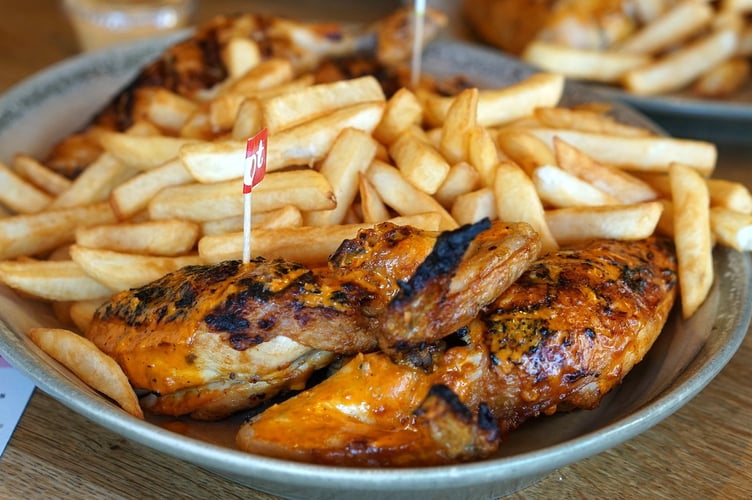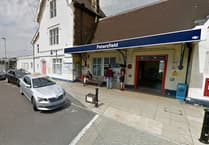Some weeks ago I mentioned it was about time I calculated the number of food or hospitality outlets we have in Farnham now. And I wondered how many of them were sustainable.
I have taken time to walk around the town, taking photos and counting the number of restaurants, pubs, cafes, takeaways and other shops serving drinks and food for consumption – but have excluded the likes of Waitrose, Poundland, Lidl and Holland & Barrett and properties in Brightwells.
I have also excluded the former HSBC building which was under offer to a food takeaway business and I think that is the most likely end use.
Survey area
The area of coverage I have taken is from the Farnham Tandoori in the west to Papa John’s Pizza in the east and from the Castle in the north to the A31 in the south.
Sixty five
The total number of food / drink outlets which I counted within the area excluding Brightwells is 65. This equates to approximately 42 per cent of the total number of shop units in the area covered.
Zombie coffee shops
I put this to one of the commercial agents I speak to regularly, and his response was: “Unless there is a massive change in footfall, I don’t see how that is sustainable.”
I think I have mentioned ‘zombie’ coffee shops before where they are just surviving or being subsidised by another income. I fear we will see more of that which is bad for local business really, as the larger chains will survive whereas the small local offers, which are generally better, and certainly more interesting, will fold. A somewhat depressing thought.
Bedding-in period
When Brightwells ‘finally’ opens, Curchod & Co have talked about keeping the number of retail outlets there separate from their main survey, for a bedding-in period. No period has been discussed but I would guess at least four quarterly surveys.
Numbers including Brightwells
The total number of all retail outlets – ie all shops, restaurants, pubs, etc, included within their survey – is 153 in the area they cover. The addition of 33 retail units in the Brightwells development (25 shops and eight restaurants, according to Crest’s currently reported numbers) make a total of 186.
Change in vacancy rate
The official nine per cent vacancy rate reported last time, excluding Brightwells, was based on 14 vacant units from a total of 153. Add to this the 33 retail units at Brightwells (total 186) and from what Crest have reported so far, in my opinion potentially between 25 and 29 vacant units there when it opens, giving an overall total of between 39 and 43 vacancies, it equates to between 21 per cent and 23 per cent, quite an increase, which blows the official vacancy rate, which I reported recently, out of the water.
Accepted view
The accepted view is that shop businesses where their merchandise can be bought on the internet are leaving the high street – not exclusively, obviously, but there is a trend – while shopping sectors where you need to be there in person are either growing or not decreasing.
We have seen a growth of hairdressers, nail bars and the like, together with cafes and restaurants which supports this belief.
Reported improvement
Recent research, with the ensuing reports published both in America and the UK, says otherwise, though. This is great news, if true.
In the UK, PricewaterhouseCoopers reported a “significant slowdown of closures from both before and during the pandemic, with 34 closures per day in H1 (the first half) of 2022 compared to 61 per day in the first half of 2020”, and “The rebound for physical stores may be partially driven by some consumers making a conscious change.
“Globally, 47 per cent of consumers said they were significantly more likely to purchase from brands who had a local presence.”
The strength of brick and mortar is expected to continue. Research by Forrester’s, an American retail research and consultancy company, predicts that in 2024, 72 per cent of US retail sales will still happen in-store. Will the UK follow?
Glimmer of hope
If this is true, it means there could be a glimmer of hope for Brightwells, although I remain convinced the scale and height of the development is utterly wrong for our town.
Brightwell numbers
The number of units proposed has increased as a result of the subdivision of the space M&S Foods were going to occupy, although Brightwell House will no longer be subdivided into two units.
It is slightly unclear now exactly how many units are available – Crest haven’t updated the numbers to reflect the changes implemented.
One thing I think for sure is there will be yet more units selling food and drink when you factor in cafes, which I am sure will contribute to the final occupation in the development.

Nando’s
I have heard recently from more than one source that Crest are talking about Nando’s taking space in Brightwells. Nando’s specialise in Portuguese flame-grilled peri-peri style chicken. Another possible food outlet.
Costa Coffee drive-thru
Another interesting development is the planning application to construct a drive-through Costa Coffee in the car park of the Farnham Retail Park in Guildford Road. When is enough, enough?
Add together the existing 60-plus places with those likely to arrive at Brightwells, together with another half-dozen or thereabouts, like the former HSBC and others that are viewing vacant shops, and we could have in excess of 80 eateries in Farnham. I would predict 85.
Lack of staff and accommodation
I bumped into George Murray, the owner of Coffee Diem, when talking the photographs and asked what he thought of the growing number of cafes, restaurants and bars.
He told me: “I think it is great that we have four new eating establishments opening in Lion and Lamb Yard – it shows confidence in the town and I think they will complement the existing offerings.
“I hope they will help to create a new market for Lion and Lamb to become more of an evening destination.
“However, I believe the limiting factor on all hospitality businesses in Farnham is the lack of staff and affordable accommodation.”
Acceleration of numbers
Obviously, many restaurants and cafes have replaced other similar businesses that were trading there before them, but the number of new place openings has accelerated recently.
It’s arguably better to have a shop occupied by a café than vacant, and some shops have been replaced by non-hostelry uses – but the trend is the opposite way.
Forty-five percent
Returning to the number of food / drink outlets and my prediction of the likely further increase, I would suggest we are likely to see the percentage of food / drink outlets of the total modified supply of shop as being in excess of 45 per cent.
In my view this is unsustainable.
Remember?
Some business names to bring back some memories – Vienna Restaurant, Okomoko, Mahaan Indian, Kentucky Fried Chicken, the Coach Bar & Restaurant, then retail businesses that became eateries, Autobits (now the Barista Lounge), James Smyth Ltd haberdashery (now the Slug & Lettuce), Lime Blue Jewellery (now Gail’s), David Steel men’s clothing (now MyFroyoland), Kelway Estate Agents (now the Gorge Café), AHC Tools (now Papa John’s), Monsoon (now the Wine Yard) and Southern Domestic Appliances (now the Barn Bistro).
Planners
Several people have said to me planners should control the number of restaurants, pubs, bars and cafés, etc.
Planning legislation is making it easier for new restaurants and cafe businesses to open up. They were fairly unconcerned when others have raised the issue of restaurants become bars or pubs.
What do I think?
I just hope we don’t get overwhelmed by them all.
Time will tell.




